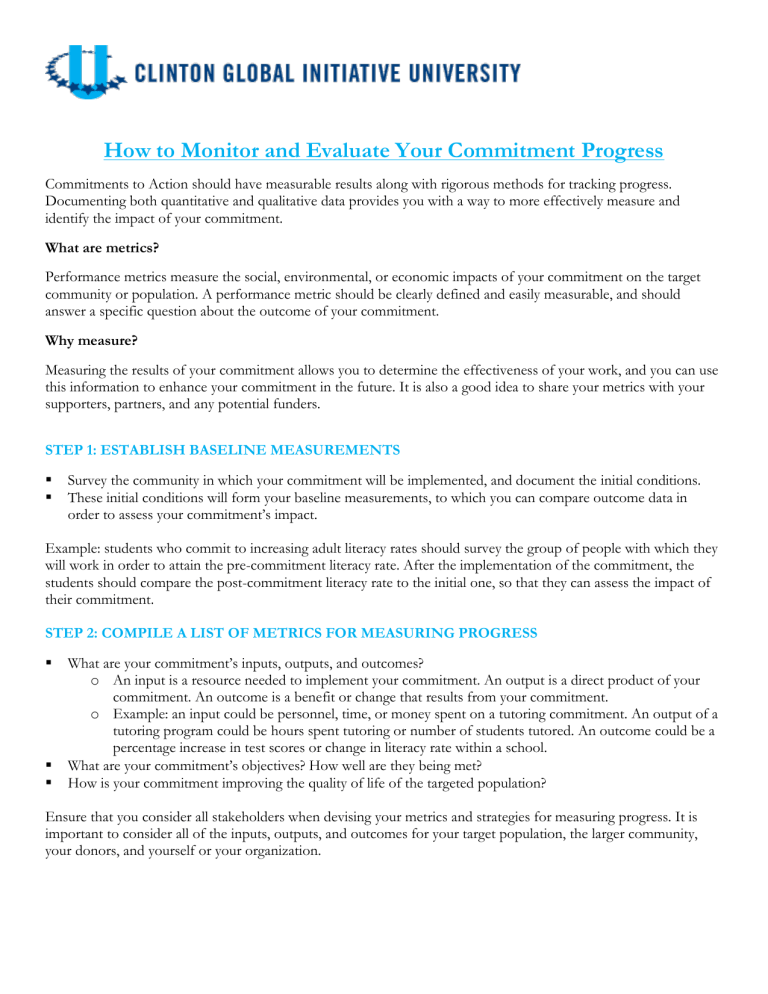How to Monitor and Evaluate Your Commitment Progress

How to Monitor and Evaluate Your Commitment Progress
Commitments to Action should have measurable results along with rigorous methods for tracking progress.
Documenting both quantitative and qualitative data provides you with a way to more effectively measure and identify the impact of your commitment.
What are metrics?
Performance metrics measure the social, environmental, or economic impacts of your commitment on the target community or population. A performance metric should be clearly defined and easily measurable, and should answer a specific question about the outcome of your commitment.
Why measure?
Measuring the results of your commitment allows you to determine the effectiveness of your work, and you can use this information to enhance your commitment in the future. It is also a good idea to share your metrics with your supporters, partners, and any potential funders.
STEP 1: ESTABLISH BASELINE MEASUREMENTS
Survey the community in which your commitment will be implemented, and document the initial conditions.
These initial conditions will form your baseline measurements, to which you can compare outcome data in order to assess your commitment’s impact.
Example: students who commit to increasing adult literacy rates should survey the group of people with which they will work in order to attain the pre-commitment literacy rate. After the implementation of the commitment, the students should compare the post-commitment literacy rate to the initial one, so that they can assess the impact of their commitment.
STEP 2: COMPILE A LIST OF METRICS FOR MEASURING PROGRESS
What are your commitment’s inputs, outputs, and outcomes? o An input is a resource needed to implement your commitment. An output is a direct product of your commitment. An outcome is a benefit or change that results from your commitment. o Example: an input could be personnel, time, or money spent on a tutoring commitment. An output of a tutoring program could be hours spent tutoring or number of students tutored. An outcome could be a percentage increase in test scores or change in literacy rate within a school.
What are your commitment’s objectives? How well are they being met?
How is your commitment improving the quality of life of the targeted population?
Ensure that you consider all stakeholders when devising your metrics and strategies for measuring progress. It is important to consider all of the inputs, outputs, and outcomes for your target population, the larger community, your donors, and yourself or your organization.
STEP 3: DOCUMENT AND RECORD DATA
Quantitative Data
Quantitative data can be counted or expressed numerically, and can be represented visually in graphs or charts.
Examples of specific metrics: number of lives affected, number of products sold, amount of money spent, amount of energy saved, or number of children with access to textbooks. There is a huge range of options for quantitative data depending on the exact scope and focus of your commitment.
Use a program like Excel to make record-keeping simple and efficient.
Qualitative Data
Qualitative data can be observed, but not quantified. Instead of using numbers, qualitative data is expressed in categories, descriptions, and text.
Examples: feedback from your target community, success stories, case studies, survey responses, personal interviews, field notes.
STEP 4: ANALYZE DATA
Determine whether your data indicates positive change in your target community and whether you have met the goals of your commitment.
If you did not meet your goals, consider making modifications to your commitment plan.
Consider whether you should revise your list of metrics or use a different data-collecting method in the future.
You can use a chart like the one below to consolidate your information and visually organize your results.
Inputs
SAMPLE CHART OF MEASURED PROGRESS
Outputs Outcome Impact
Resources used to implement your commitment.
Example: cost of providing a loan.
Direct and tangible products of your commitment.
Example: 25 people received a loan.
Change or benefit resulting from these products.
Broader change or benefit that can be attributed to your commitment. Would any of these outcomes happened in the absence of your commitment?
Example: number of people whose quality of life improved as a result of the loan.
Example: if three out of the 25 loan recipients would have improved their quality of life without the loan, the impact of the loan should be based only on the other 22 people.
STEP 5: REPORT AND SHARE RESULTS
Create graphs, tables, and charts to visually display your data.
Write up success stories, case studies, and detailed reports. Also consider shooting video footage of your commitment’s impact and recording personal interviews with beneficiaries.
Share outputs, outcomes, and impacts with funders, partners, and the beneficiaries of your commitment.
Publish your data on your website and create resources that show your commitment results.



